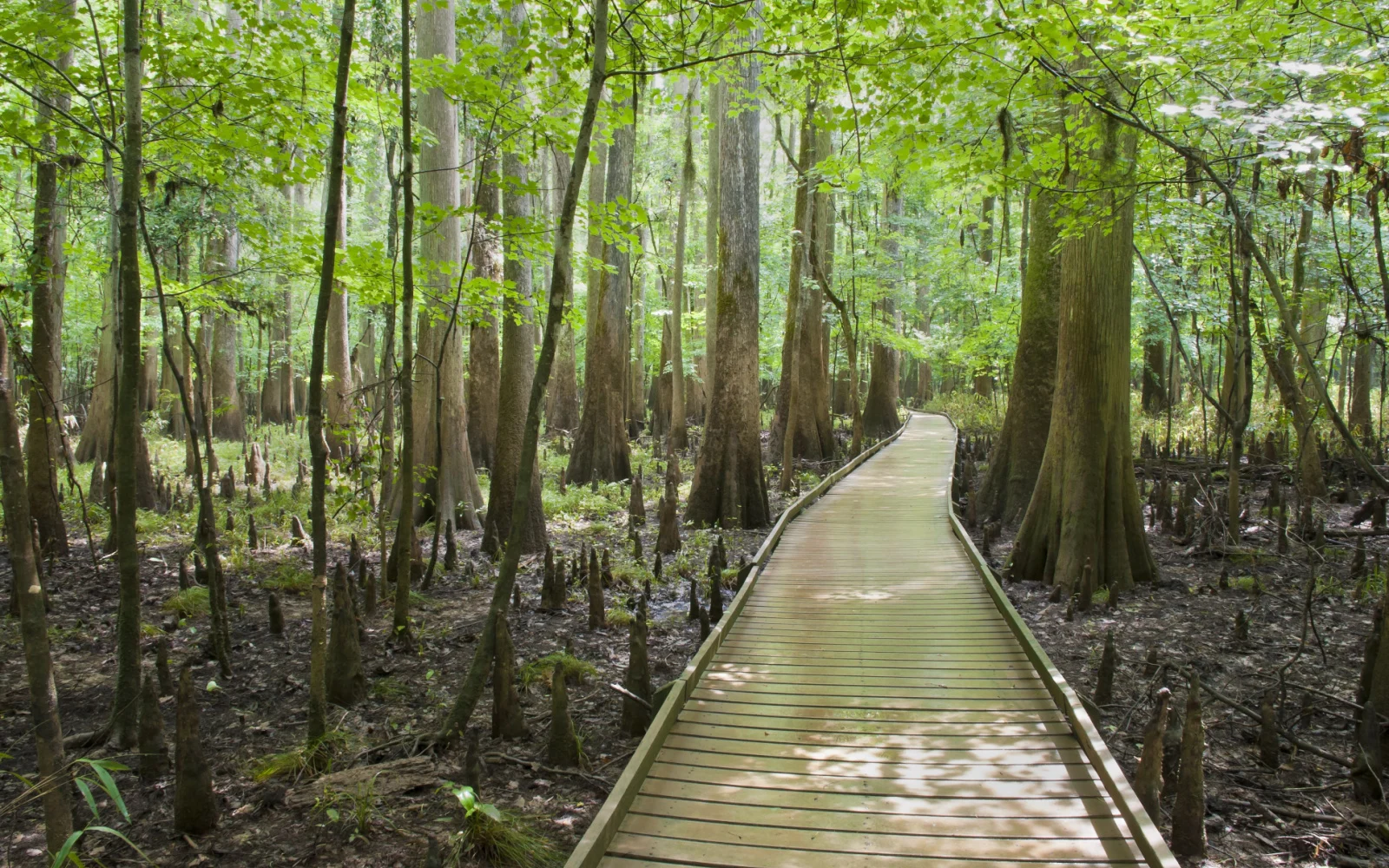What's the best time to visit Congaree National Park?
The best time to visit Congaree National Park is in spring, when mild temperatures make outdoor activities pleasant and trails like the Boardwalk Loop and Weston Lake Loop are accessible, despite the potential for rain and thunderstorms. Water levels fluctuate, affecting the wetland ecosystem, but late May and early June offer a unique experience with the firefly display.
Calling all outdoor enthusiasts: Since 2003, you can tour the Congaree National Park’s 26,000-acre water wilderness and admire giant old-growth canopies with the tallest champion trees on the east coast.
With miles of charming water trails, an elevated boardwalk to hike, and Congaree tent campgrounds. You will want to be a part of the charm. The Congaree is in the boons outside of the unique southern hospitality capital of South Carolina.
But, unlike the euphoric beauty that you find up in the alps of the Pacific Northwest. Or the nineteen desert national parks scattered around the United States; the beauty of the park is swampy: wet, rich with otherworldly habitats, and beautifully eerie.
But while there’s much to see and do, what’s the best time to visit Congaree National Park? Here’s our take.
Overall Best Time to Visit Congaree National Park
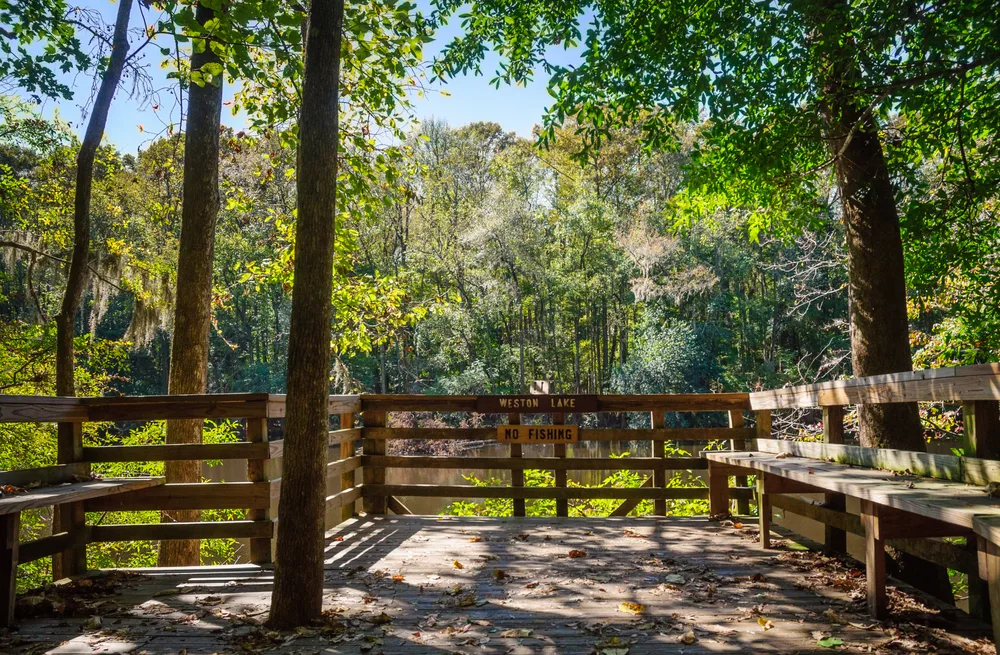
Zack Frank/Shutterstock
The overall best time to visit the Congaree is in Spring, when temperatures are mild enough to tame swarms of hungry mosquitoes and still feel comfortable in shorts and a raincoat.
However, spring rain and thunderstorms tend to surprise out-of-state visitors. Before you put your kayak on Cedar Creek, you should remember that the Congaree is a wetland.
That means a live ecosystem that ebbs and flows with the floodplain’s natural rhythm fluctuating the water levels year-round. The Congaree in the Spring is the best time to troll the park hiking trails before you venture off into the creeks.
The Boardwalk Loop Trail is a 2.6-mile loop that takes you through the bottomland’s mystical forest of loblolly pine and bald cypress trees without getting into the water.
The trail’s elevated boardwalk is easy to access by foot, wheelchair, or stroller. The Weston Lake Loop Trail flows 4.5 miles through Cedar Creek scenery with a hallmark viewpoint of Weston Lake.
A quarter-of-a-mile of the trailhead will take you to Wise Lake — follow the signs at the Weston Lake Loop and River Trail junction. It will take you right up to the sensational view.
Other trails that are short, sweet, and worth trekking through are:
- Bates Ferry Trail
- Fork Swamp Trail
- Kingsnake Trail
- River Trail
In addition, the Sims, Bluff, and Oakridge trails are easily accessible and easy to walk. But please check the weather forecast before hiking since the park’s ecosystem is a highly respected floodplain.
The water levels are not consistent and fluctuate daily. However, visitors that want a magical experience can tour flights of fireflies towards the end of May and the beginning of June.
Cheapest Time to Visit Congaree National Park
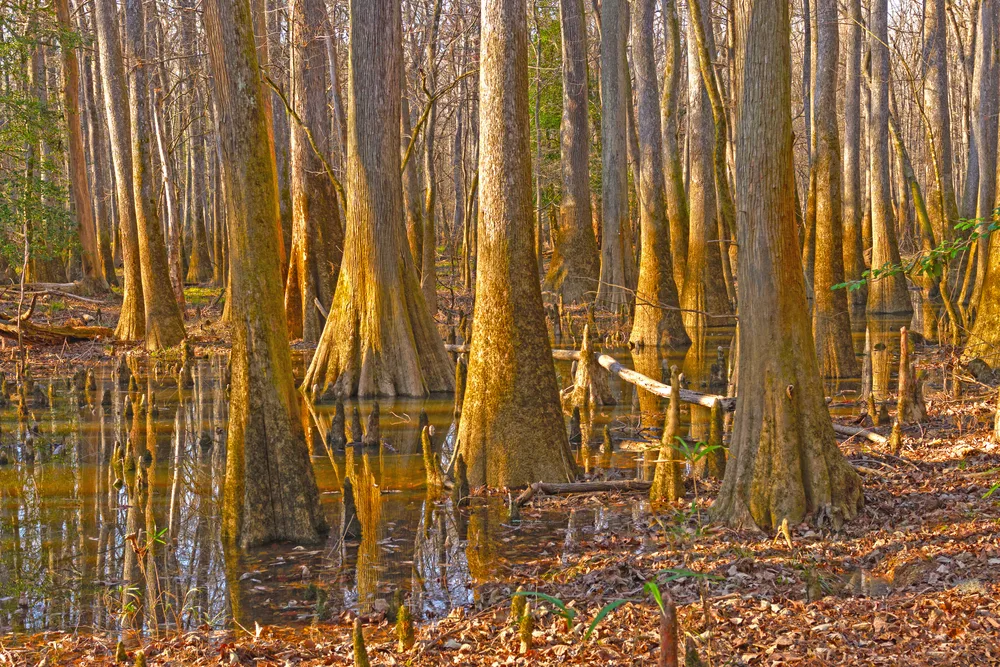
Wildnerdpix/Shutterstock
The least busy time to visit Congaree National Park is during its off-season, from late fall to early spring (November through May). During these months, accommodation rates in nearby areas are often lower due to reduced tourist traffic.
However, visiting the park is notably cost-effective thanks to its free admission, a unique feature among many U.S. National Parks. This advantage makes it an attractive choice for budget-conscious travelers.
The park can be fully explored in just two days, which significantly cuts down on accommodation costs, making a trip to Congaree an economical option. This brief duration is ideal for a short, budget-friendly getaway.
Least Busy Time to Visit Congaree National Park
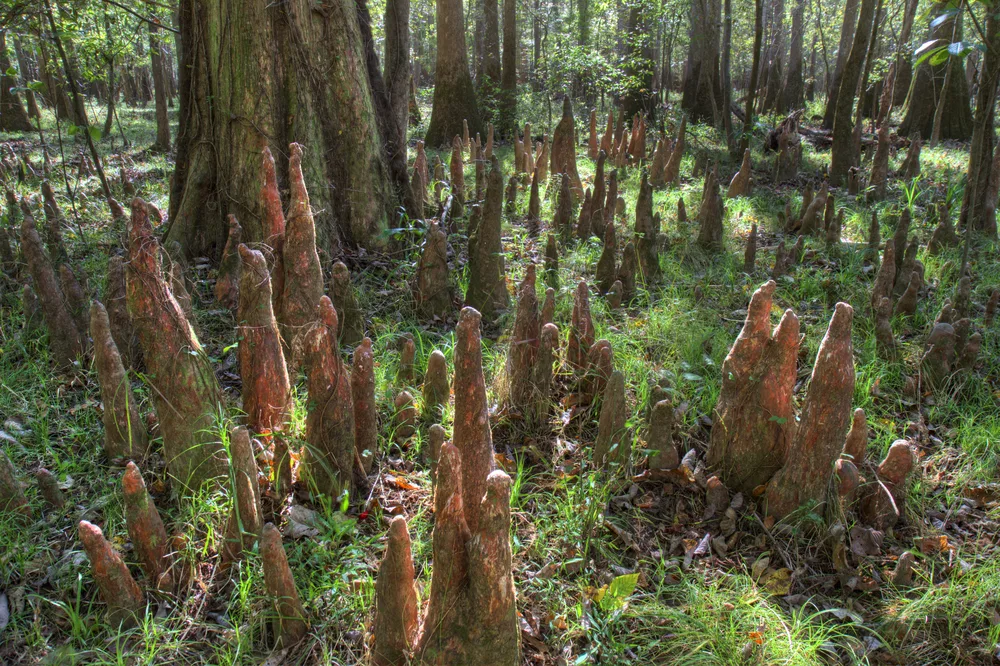
Pierre Leclerc/Shutterstock
Another pro about visiting Congaree is that most people hate it. The park rates as the worst national park in the U.S. That means the visitors you’ll likely bond with touring the floodplain are local tourists.
In addition, the park is reasonably small in comparison to America’s favorite Yosemite and Yellowstone national parks. The world’s famous U.S. National Parks are known for their size and wow-factor beauty. While other ones, like the Congaree, are rustic and soul-grabbing.
Especially during May when the rangers open the park’s door to their carefully curated Fireflies Trail for the beloved synchronous firefly show where locals and visitors can experience the glittering seas of blinking fireflies searching for the perfect mate.
Or year-round, when anglers can find largemouth bass in December, catfish in March, and bluegill in may.
And if you’re fishing from out-of-state, please remember to buy a valid South Carolina fishing license to help preserve the park’s biodiversity; and follow the park’s fishing regulations.
Worst Time to Visit Congaree National Park
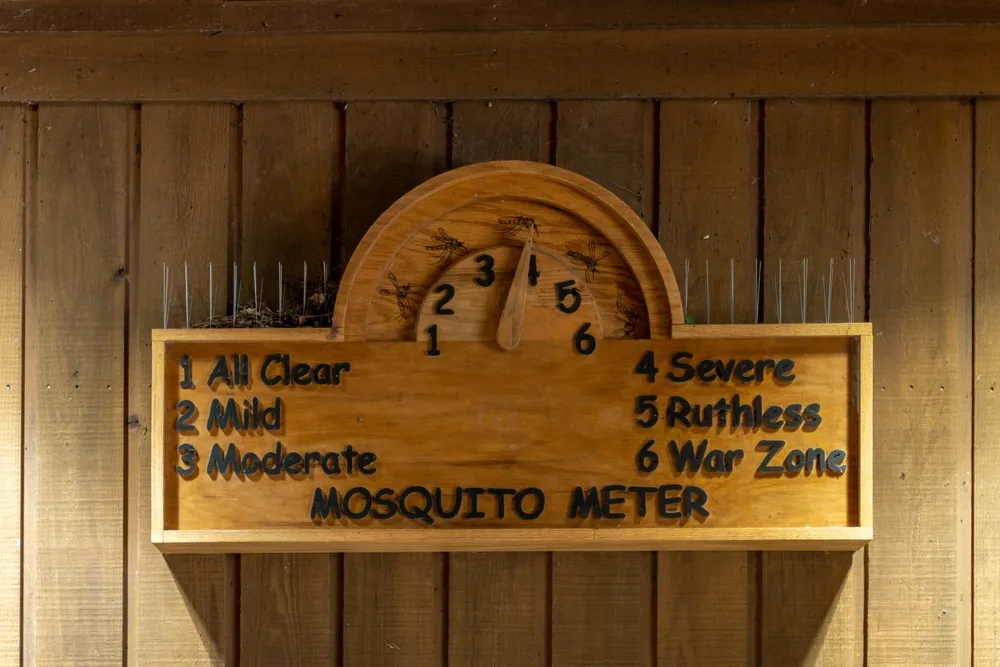
September 7, 2018: Columbia, United States: Mosquito Meter in Swampy Park/Kelly vanDellen/Shutterstock
The worst time to visit Congaree National Park is in the summer, from June until August. All of the terror that you’ve probably heard rumored about the park’s mosquito meter is true. The air can appear all clear at sunrise and turn into a buzzing war zone in the evening.
Nor do the hot temperatures stop snakes from leaving their hot dens or flesh-eating insects from hunting for you. In addition, wildlife is extraordinarily active and tends to hide underneath Poison Ivy, log jams, and downed trees.
Wildlife that is common in a Congaree summer are:
- Water Moccasin, Copperhead, and Canebrake Rattlesnakes.
- Wood Stork, Black Vultures, and hummingbirds.
- Bobcats, deer, wild pigs, and river otters.
- Mosquitoes, ticks, and deer fly.
But, when you want to experience the best side of the Redwoods East, double-check the weather forecasts to ensure the possibility of getting swept through a storm is unlikely.
Be mindful of weather alerts and advisories such as record heavy rainfall, flooding, fog, and wind quality. Summer is known for random weather patterns. However, winter is also the worst time to visit Congress water trails.
Winter stretches from the onset of November to the end of February and into early march. In addition, the water level for canoe travel has unpredictable flood stage conditions that can overtop banks, making it hard to navigate and follow the trail markers.
In addition, if exploring the water trails is the highlight of your itinerary, keep watching the weather forecast and chilly weather in upstate areas of South Carolina that converge with the Congaree.
Congaree National Park by Month: Climate & Activities
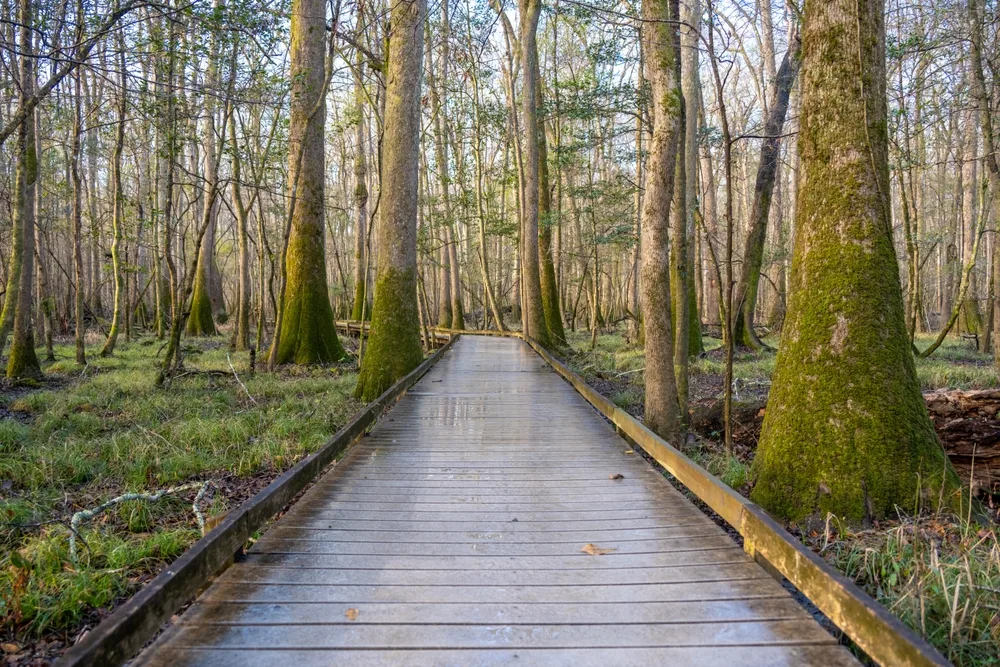
Kelly vanDellen/Shutterstock
Still unsure about the best time to visit Congaree National Park? Take a look at our summary of the weather and climate by month below:
January
January in Congaree National Park brings cool temperatures, ranging from 34 to 55°F (1-13°C). This month is ideal for peaceful walks on the boardwalk trail, bird watching, and enjoying the park’s tranquility without the crowds.
February
February continues with similar cool weather, perfect for exploring the park’s hiking trails like the Weston Lake Loop, attending ranger-led interpretive programs, and spotting wintering wildlife in the park’s diverse habitats.
March
As spring approaches, temperatures in Congaree range from 40 to 66°F (4-19°C). March is great for kayaking or canoeing in Cedar Creek, observing the awakening of spring flora, and hiking the Kingsnake Trail for a serene forest experience.
April
Spring temperatures in April range from 49 to 75°F (9-24°C). It’s an ideal time for wildflower viewing, participating in the park’s guided night walks to experience the nocturnal wilderness, and enjoying the increasingly green and lush landscape.
May
May sees warmer temperatures from 58 to 82°F (14-28°C). Explore the park’s biodiversity, enjoy fishing in the Congaree River, and experience the park’s birdlife, including the Prothonotary Warbler, in full spring activity.
June
Summer arrives with temperatures between 67 to 89°F (19-32°C). June offers opportunities for attending the Fireflies Festival to witness the synchronized fireflies display, enjoying nighttime hikes, and exploring the park’s backcountry.
July
July maintains warm temperatures from 70 to 92°F (21-33°C). It’s a popular month for attending the park’s nature and wildlife programs, exploring the sloughs and lakes by canoe or kayak, and enjoying the lush, green canopy on forest hikes.
August
Temperatures in August range from 70 to 90°F (21-32°C). Visit the Harry Hampton Visitor Center for educational exhibits, take a leisurely walk on the Boardwalk Loop Trail, and experience the park’s rich ecosystem during the humid summer months.
September
As fall begins in September, temperatures in Congaree National Park range from 64 to 85°F (18-29°C). This time is perfect for spotting migratory birds, enjoying the changing colors of the forest, and hiking the park’s longer trails like the Congaree River Trail.
October
October sees cooler temperatures from 52 to 76°F (11-24°C). Enjoy the autumnal beauty in the park, explore the floodplain forest as the water levels change, and experience the tranquility of the park in fall.
November
Fall temperatures in November range from 40 to 66°F (4-19°C). This month is ideal for camping in the park’s designated backcountry areas, taking photography hikes to capture the fall scenery, and canoeing in the peaceful waterways.
December
Winter brings cooler temperatures ranging from 34 to 57°F (1-14°C). December offers a quiet and serene park experience, with opportunities for spotting wintering birds, enjoying crisp hikes, and experiencing the peacefulness of the park’s winter landscape.
Frequently Asked Questions
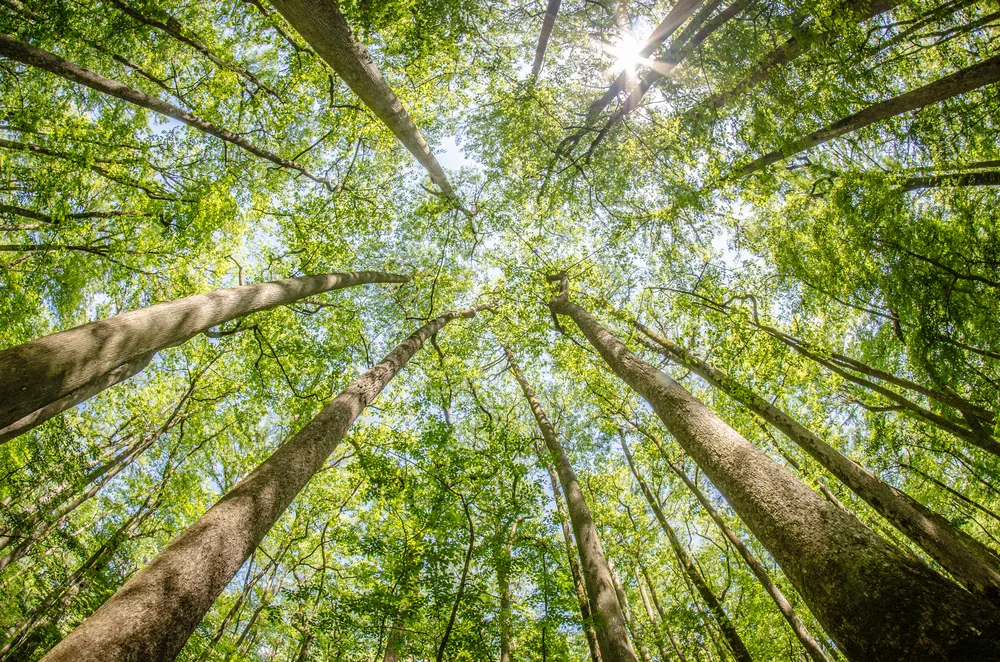
digidramgrafix/Shutterstock
If visiting the Congaree National Park is calling, check out these frequently asked questions to help you choose the right time to visit the Congaree:
Do you need reservations for Congaree National Park?
No, you do not need reservations for the Congaree National Park. The park has no entrance fee giving you unlimited access to hiking, kayaking, fishing, and ranger-led programs.
However, overnight campers that want access to the parks, the front country campgrounds, Longleaf, and Bluff must book a reservation at least three days in advance. Backcountry campers must obtain a permit to set up camp.
Can you stay in Congaree National Park?
Yes, you can stay in the Congaree National Park at the designated front country and backcountry campgrounds with tents and hammocks for up to 14 days.
The Longleaf Campground has 14 campsites equipped with a fire ring and picnic table. The Bluff campground has six campsites and no vehicle, restroom, or running water access. However, you cannot stay overnight in your vehicle.
Campers must remain at their reserved campground or permit stays. In addition, the park does not have R.V. and trailer hookups. R.V.s, trailers, and van campers can find accommodations at local campgrounds.
What city is closest to Congaree National Park?
Columbia city is the closest urban city to the Congaree National park – just 18 miles and 30 minutes away. Columbia city is the capital of South Carolina, rich with history that dates back to 1823.
Aside from the Riverbanks Zoo and Garden, Columbia Museum of Art, and Robert Mills garden house, Columbia is a culinary museum for the United States’ best BBQ, and southern comfort eats.
Other popular cities nearby the Congaree include Myrtle Beach, South Carolina; Asheville, North Carolina; and Savannah, Georgia– making it easy to tour your favorite parts of the South in less than four days.
So, When Is the Best Time to Visit Congaree National Park?
Although the Congaree National Park may have a bad reputation for meat-eating insects and a lack of alien-like natural monuments, the park is in a class of its own. Redwoods East is an ancient forest bed that emits a different kind of beauty, even when no one is around.
This forest hums so quietly that you must be quiet enough to hear the stories of how, when, and where these champion trees grew to become champions. So what are you waiting for — book your trip today!



